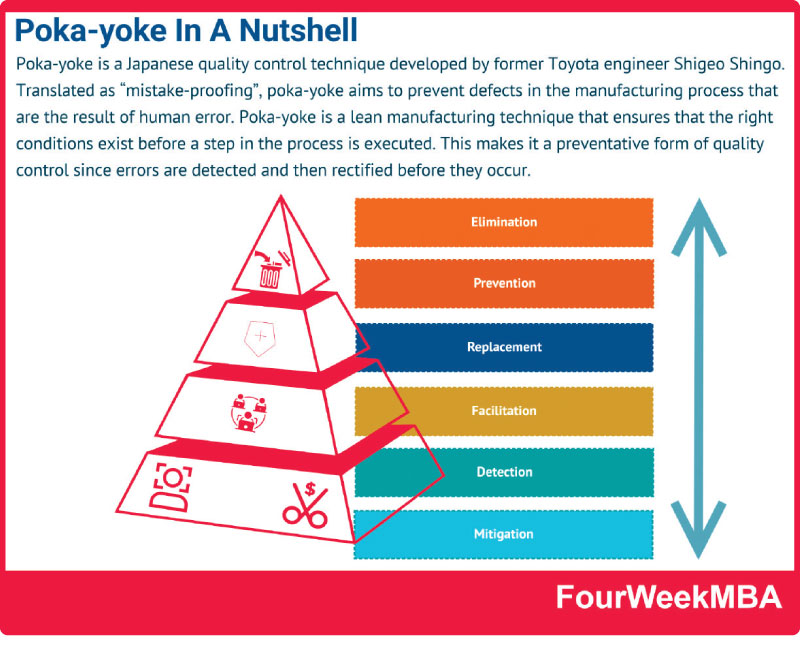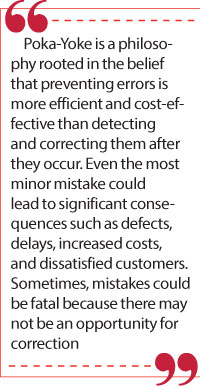Thursday Dec 18, 2025
Thursday Dec 18, 2025
Thursday, 7 September 2023 00:24 - - {{hitsCtrl.values.hits}}

 This article briefly introduces Poka-Yoke (pronounced Poh Kah Yoh Kay), an essential technique to error-proof your office, factory or farm. It is a Japanese technique with a focus on mistake-proofing. Many call it fool-proofing or idiot-proofing. However, the Japanese do not believe that any human being is a fool or an idiot, but believe humans can cause errors.
This article briefly introduces Poka-Yoke (pronounced Poh Kah Yoh Kay), an essential technique to error-proof your office, factory or farm. It is a Japanese technique with a focus on mistake-proofing. Many call it fool-proofing or idiot-proofing. However, the Japanese do not believe that any human being is a fool or an idiot, but believe humans can cause errors.
The Poka-Yoke philosophy
Poka-Yoke is a philosophy rooted in the belief that preventing errors is more efficient and cost-effective than detecting and correcting them after they occur. Even the most minor mistake could lead to significant consequences such as defects, delays, increased costs, and dissatisfied customers. Sometimes, mistakes could be fatal because there may not be an opportunity for correction. The concept was introduced by Shigeo Shingo, a Japanese industrial engineer, as part of the Toyota Production System (TPS). The primary goal of Poka-Yoke is to design processes and systems in a way that prevents human errors or mistakes from causing defects.
Ten types of errors
In tackling errors, a critical phase is to understand the error types. One method is to classify them as follows according to Hiroyuki Hirano the author of POKA-YOKE, Mistake Proofing for Zero Defects:
Intentional errors: Caused deliberately to sabotage the process, perhaps by an unhappy employee or as revenge.
Hasty errors: Impatient people who do not read instructions thoroughly nor listen to instructions carefully could cause these errors.
Careless errors: Sometimes called forgetful errors, and forgetful people can cause these errors.
Casual errors: Caused by not paying attention to the work at hand or the environment. Superficial observations or distractions often cause these.
Amateurish errors: Caused by a lack of experience or attempting to do a task without proper skills or training.
Compulsive errors: Caused by those who refuse to heed the rules and standards and repeatedly make the same mistake over and over.
Thoughtless errors: These result from people who need to be more focused or are inattentive to the surrounding environment.
Timing errors: People with a slower response are responsible for these errors. The delay in immediately stopping a machine when it produces defective components is a timing error. A motorist under the influence of alcohol may have a slow response.
Irresponsible errors: This occurs when there are no clear, unambiguous and detailed work instructions, and therefore, people decide how to carry out a task. Very often, this situation leads to high variability and many errors.
Out-of-the-blue errors: This happens when no one can explain the cause of a malfunction or a defect. It suddenly came “out of the blue.”
 Poka-Yoke responses
Poka-Yoke responses
The responses to each type of error would differ but often include more training, updates, meetings, better supervision, proper work instructions, better discipline, creating an error-free culture, motivation, employee engagement, etc. In factories and the service sector, it is common to see simple methods such as the shape, dimension, and weight methods in use. Examples are your mobile SIM card with a shape that refuses to go in unless inserted correctly. In a factory, the piece worked on will only fit into the mould if the item is placed in the correct direction. In a QC line, the packed box will only pass on the conveyor belt if the proper weight is recorded, which ensures that every component is included. Visual controls such as colour coding is another effective method. An example is colour coding the cooking gas cylinder and the recipient pipeline with the same colour while the oxygen cylinder and the oxygen pipeline are in another colour. Your car will not start in a gear position. It needs to be in PARK position with your foot pressing the brake pedal.
With modern sensors being available now, many sensor detection mechanisms will ensure that a defect-free article goes to the customer and will ensure a safer workplace too.
Poka-Yoke is helpful in simple as well as in complex operations. You must focus on ensuring that human errors are minimised or eliminated.
(The writer is a Management Consultant and specialist in Enterprise Productivity and Japanese Management Techniques.)